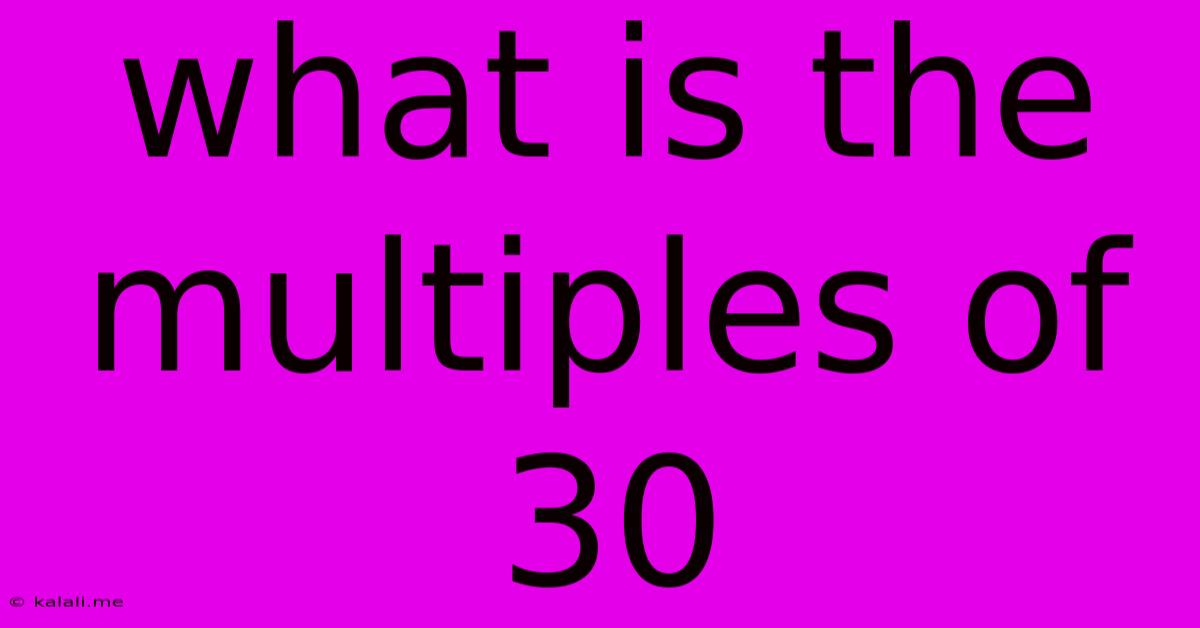What Is The Multiples Of 30
Kalali
Jun 13, 2025 · 3 min read

Table of Contents
What are the Multiples of 30? A Comprehensive Guide
Finding the multiples of 30 might seem simple at first, but understanding the concept thoroughly opens doors to more advanced mathematical concepts. This guide will comprehensively explain what multiples of 30 are, how to find them, and their significance in various mathematical applications. This article will also cover identifying multiples, using multiplication tables, and exploring patterns within these multiples.
What are Multiples?
Before diving into the multiples of 30 specifically, let's define what a multiple is. A multiple of a number is the product of that number and any integer (whole number). For example, multiples of 5 include 5 (5 x 1), 10 (5 x 2), 15 (5 x 3), and so on. Essentially, multiples are the results you get when you repeatedly add a number to itself.
Finding the Multiples of 30
The multiples of 30 are the numbers you obtain by multiplying 30 by any whole number. This includes both positive and negative integers, although we often focus on the positive multiples.
Here are the first few positive multiples of 30:
- 30 x 1 = 30
- 30 x 2 = 60
- 30 x 3 = 90
- 30 x 4 = 120
- 30 x 5 = 150
- 30 x 6 = 180
- 30 x 7 = 210
- 30 x 8 = 240
- 30 x 9 = 270
- 30 x 10 = 300
And so on, infinitely. You can continue this pattern indefinitely by multiplying 30 by progressively larger integers.
Identifying Multiples of 30
There's a simple trick to quickly identify if a number is a multiple of 30: A number is a multiple of 30 if it is divisible by both 10 and 3. This means it must end in a 0 (divisible by 10) and the sum of its digits must be divisible by 3. Let's test this with a few examples:
- 150: Ends in 0, and 1 + 5 + 0 = 6 (divisible by 3). Therefore, 150 is a multiple of 30.
- 270: Ends in 0, and 2 + 7 + 0 = 9 (divisible by 3). Therefore, 270 is a multiple of 30.
- 340: Ends in 0, but 3 + 4 + 0 = 7 (not divisible by 3). Therefore, 340 is not a multiple of 30.
This divisibility rule provides a fast way to check for multiples of 30 without performing the actual division.
Using Multiplication Tables
Multiplication tables are a helpful tool, especially for finding smaller multiples of 30. You can find the multiples by simply looking at the "30 times" row in a multiplication table.
Patterns in Multiples of 30
Notice that all multiples of 30 are even numbers and end in 0. This is because 30 itself is an even number and a multiple of 10. The sequence of multiples exhibits a consistent increase of 30 with each successive term. Understanding these patterns can be beneficial in various mathematical problems and applications.
Applications of Multiples of 30
Understanding multiples is crucial in various fields:
- Measurement: Converting units of measurement often involves working with multiples (e.g., converting minutes to seconds).
- Scheduling: Multiples are used in scheduling events that occur at regular intervals.
- Geometry: Calculating areas and perimeters frequently uses multiples.
In conclusion, grasping the concept of multiples, specifically those of 30, provides a foundational understanding for more advanced mathematical concepts and proves useful in various practical applications. By understanding the simple divisibility rule and utilizing multiplication tables, you can easily identify and work with multiples of 30 efficiently.
Latest Posts
Latest Posts
-
What Is The Difference Between A Square And Rhombus
Jun 14, 2025
-
The Normal Rbc Graveyard Is The Liver
Jun 14, 2025
-
Can You Reschedule A Sat Test
Jun 14, 2025
-
Able To Be Drawn Into Wire
Jun 14, 2025
-
Which Of The Following Statements Is True Regarding
Jun 14, 2025
Related Post
Thank you for visiting our website which covers about What Is The Multiples Of 30 . We hope the information provided has been useful to you. Feel free to contact us if you have any questions or need further assistance. See you next time and don't miss to bookmark.